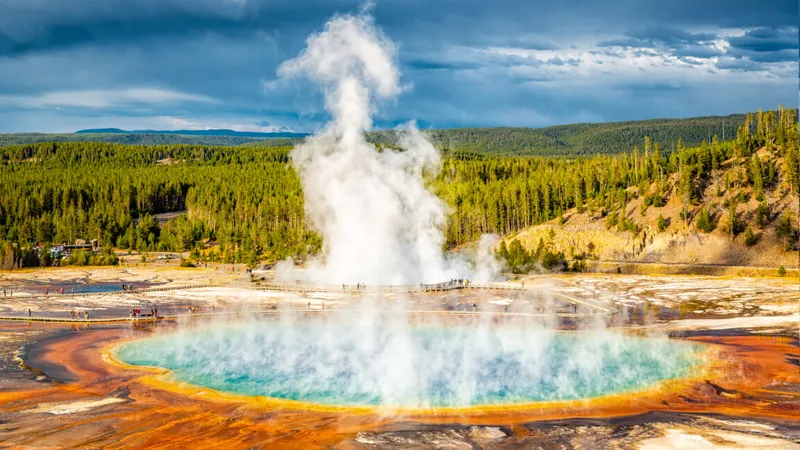
Breathe Easy, Yellowstone Lovers: Insights from Recent Studies Show Eruptions Unlikely in 2025!
2025-01-03
Author: Yan
A staggering volume of 1,000 cubic kilometers of rock is hard to visualize, especially when imagining it blasted into the atmosphere. Yet, the Yellowstone volcanic system unleashed over double that amount during massive eruptions two million years ago, leaving many with lingering concerns about its potential for destruction. However, a groundbreaking new study suggests there's no imminent threat from Yellowstone: recent findings indicate that sufficient molten material is not present to trigger the kind of cataclysmic eruptions witnessed in the past.
What’s Happening Beneath Yellowstone?
The Yellowstone volcanic system is fueled by a "hotspot," a location where molten materials softly rise from deep within the Earth’s mantle, making their way through the crust. The type of rock that emerges is primarily basaltic, leading to gentle eruptions similar to those seen in volcanic regions like Hawaii and Iceland. Still, these magma flows can also melt surrounding rock, producing rhyolite—a material much thicker and capable of generating explosive eruptions.
The current concern centers on the risks posed by these rhyolitic eruptions. Differentiating between the two types of molten materials deep underground remains a challenge; various studies have explored seismic waves traversing the region, but conflicting data has yielded numerous unanswered questions.
To overcome these challenges, researchers have employed innovative magnetotelluric measurements that analyze the conductivity of rocks. This method provides clearer insights into the composition of material below Yellowstone, revealing significant details previously obscured by resolution limitations in earlier studies.
Mapping the Lava: Breaking Down Yellowstone’s Volcanic Plumbing
With a network of sensors strategically placed throughout the Yellowstone caldera, researchers have crafted a detailed 3D map of the molten materials lying beneath the surface. It reveals two significant streams of molten material originating from the boundary between the Earth’s mantle and crust, around 50 kilometers down. As these streams rise, they unite approximately 20 kilometers below the surface.
The researchers estimate a total of 4,000 to 6,500 cubic kilometers of basaltic magma exists within these streams. However, the material remains dispersed through cracks and faults in solid rock, inhibiting the concentration necessary for eruptions.
Once these molten streams merge, they create a reservoir characterized by a small volume of rhyolitic material—under 500 cubic kilometers. While this could potentially trigger a small eruption, such an event is deemed highly unlikely due to insufficient material concentration.
What Lies Ahead? Potential Risks and Future Developments
Just south and west of the main reservoir lie two minor blobs of molten material: one containing roughly 100 cubic kilometers and the other less than 50 cubic kilometers. Because the latter sits below a larger basaltic pool, it could be subjected to heat, raising questions about future activity.
Interestingly, geothermal environments like the Norris Geyser Basin and Hot Springs Basin also play a role in Yellowstone's geothermal activity. The latter contains small amounts of rhyolitic material; however, it is insufficient to instigate an eruption. On the other hand, the northeast region showcases the most significant volume of rhyolitic material (up to 500 cubic kilometers) and remains connected to the primary molten flow within the crust. Although currently stable, this area presents the highest potential for future eruptions.
Looking Ahead: A New Era of Understanding
In essence, while the Yellowstone volcanic system harbors plenty of molten rock, its distribution is too diffuse within solid rock to precipitate a major eruption in the near future. There would need to be fundamental changes before we witness ash falling across North America again.
The findings offer a new perspective on the long-term behavior of Yellowstone's hotspot, shaping various eruptions across western North America as the North American plate migrates over it. One significant takeaway is that a disconnected pool of molten material in the west may cool off, altering the volcanic landscape, while the greater near-surface reservoir to the east may incite future explosive activity beyond the caldera itself.
Feel free to explore more about this fascinating study published in *Nature*, which provides critical insight into our planet’s dynamics and the relatively calm future awaiting Yellowstone!

 Brasil (PT)
Brasil (PT)
 Canada (EN)
Canada (EN)
 Chile (ES)
Chile (ES)
 Česko (CS)
Česko (CS)
 대한민국 (KO)
대한민국 (KO)
 España (ES)
España (ES)
 France (FR)
France (FR)
 Hong Kong (EN)
Hong Kong (EN)
 Italia (IT)
Italia (IT)
 日本 (JA)
日本 (JA)
 Magyarország (HU)
Magyarország (HU)
 Norge (NO)
Norge (NO)
 Polska (PL)
Polska (PL)
 Schweiz (DE)
Schweiz (DE)
 Singapore (EN)
Singapore (EN)
 Sverige (SV)
Sverige (SV)
 Suomi (FI)
Suomi (FI)
 Türkiye (TR)
Türkiye (TR)
 الإمارات العربية المتحدة (AR)
الإمارات العربية المتحدة (AR)